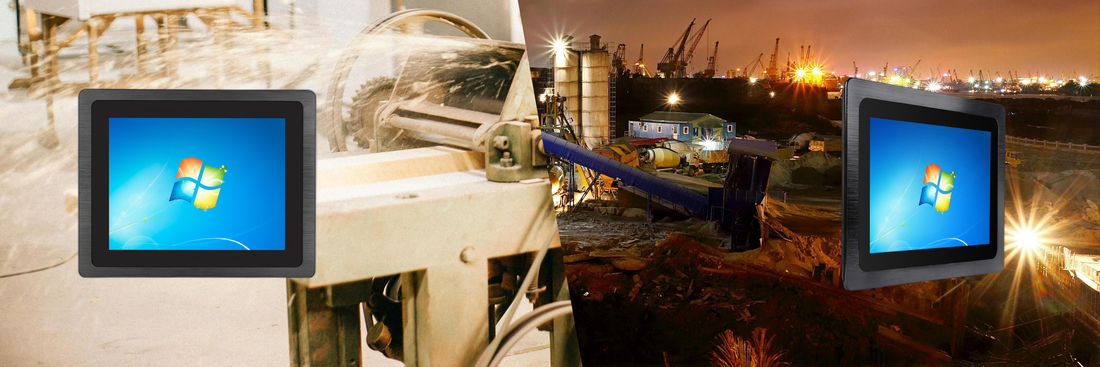
Comprehensive Guide to Industrial Ruggedized Computers: Choosing the Right Solution for Harsh Environments
Comprehensive Guide to Industrial Ruggedized Computers: Choosing the Right Solution for Harsh Environments
Introduction
Ruggedized computers have become essential in many industries, especially those operating in volatile environments. Whether it's an oil rig, manufacturing plant, or military application, ruggedized PCs are designed to withstand extremes that traditional commercial-grade computers cannot. This comprehensive guide will walk you through the key features of ruggedized computers, explain their unique benefits, and provide tips for choosing the right ruggedized solution for your needs.
What Are Ruggedized Computers?
Ruggedized computers are industrial-grade systems built specifically to handle the challenges of harsh and unforgiving environments. Unlike standard commercial PCs, which are built for general use, ruggedized computers are engineered to operate reliably under conditions such as:
- High exposure to dust and debris
- Extreme temperatures ranging from freezing to scorching
- Frequent shocks and vibrations
- Humidity and moisture exposure
In addition to being durable, ruggedized computers are tested rigorously in laboratories to ensure that they meet strict performance and reliability standards. This robust testing is necessary to guarantee their survival in environments that would cause traditional PCs to malfunction.
Key Features of Ruggedized Computers
-
Superior Build Quality & Ruggedization
Rugged computers are typically encased in strong metal housings (such as aluminum or copper) designed to efficiently dissipate heat generated by internal components. This not only provides protection from physical damage but also improves performance by keeping the system cool. One of the most significant aspects of ruggedization is the elimination of fans, making the computer resistant to dust and debris, which could otherwise enter the system and cause failures. -
Shock and Vibration Resistance
Industrial ruggedized computers are built to withstand intense shocks and vibrations, a crucial feature for environments such as vehicle deployments or heavy machinery operations. These computers are engineered to handle frequent movement and jolts without damaging their internal components. For instance, they often comply with the military-grade MIL-STD-810G standard, which certifies their durability under extreme mechanical stress. -
Dust & Debris Protection
Many ruggedized PCs operate in dusty and dirty environments, from mining operations to deserts. Their fanless design eliminates the need for ventilation, which helps prevent debris from entering the system. These computers often carry ingress protection (IP) ratings, with some models offering IP65 or IP67 certification, making them resistant to both dust and water. -
Extreme Temperature Tolerance
Ruggedized computers are designed to operate under extreme temperatures, from as low as -40°C to as high as 85°C. This makes them suitable for environments like arctic exploration, desert oil fields, or industrial freezers. The fanless cooling design enhances their ability to perform consistently, regardless of external temperature fluctuations. -
Industrial-Grade Components
Despite sharing similar hardware components (e.g., CPU, GPU, RAM) with regular PCs, ruggedized computers use industrial-grade materials that are tested to ensure reliability in volatile environments. These include advanced PCBs, industrial capacitors, and solid-state drives (SSDs) for increased resistance to shocks and vibrations compared to traditional spinning hard drives. -
Expandability and Longevity
One key advantage of ruggedized computers is their long operational lifespan and expandability. Equipped with durable components, these systems often come with multiple expansion slots for additional I/O ports or connectivity upgrades. The PCIe architecture is commonly used to support performance upgrades such as GPUs and field-programmable gate arrays (FPGAs), ensuring the system can scale alongside technological advancements. -
Power Efficiency & Protection
Ruggedized PCs often feature a wide range of power inputs (9 to 50 VDC), making them adaptable to diverse power sources. Additionally, built-in power protections such as overvoltage, surge, and reverse polarity protections safeguard the system from electrical anomalies. This is crucial in remote or industrial settings where power stability can be unpredictable. -
Compact Design & Mounting Flexibility
Many ruggedized computers come in compact designs, making them ideal for space-constrained environments. Various mounting options—like VESA, DIN rail, and wall mounts—provide flexibility in installation, whether in vehicles, factories, or outdoor locations. The small form factor doesn't compromise on performance but allows the system to be deployed even in tight, challenging spaces. -
Connectivity Options
Ruggedized computers support a wide array of wired and wireless connectivity options. These include Gigabit Ethernet, high-speed USB 3.1, and legacy COM ports, as well as wireless technologies like Wi-Fi 6 and 4G/5G cellular networks. Some models also come with Bluetooth and physical SIM sockets for multi-carrier wireless coverage. These features make ruggedized systems ideal for IoT applications, remote monitoring, and machine-to-machine communication.
Applications of Ruggedized Computers
-
Manufacturing
In manufacturing plants, ruggedized computers are used to monitor machine operations and process sensor data for predictive maintenance. These systems are reliable, even in environments filled with dust, vibrations, and high temperatures, making them ideal for tracking production efficiency and interacting with human-machine interfaces (HMIs). -
Industrial Automation and Robotics
Industrial automation is heavily reliant on ruggedized PCs to handle real-time data processing and control robotic systems. These systems are crucial in industries like automotive manufacturing, where precision and durability are key. Edge computing in this domain involves integrating GPUs for inference and image recognition tasks. -
Security and Surveillance
Ruggedized PCs are vital in security applications for real-time data analysis and edge computing. In mass transit vehicles or harsh outdoor environments, these systems provide critical data analysis and image recognition without relying entirely on cloud computing. They reduce latency by processing information locally and sending only vital data to the cloud. -
Military Applications
Military applications of ruggedized computers are vast. These systems are deployed for ground control, surveillance, and communication in the most extreme environments. Whether on land, at sea, or in the air, military-grade rugged PCs meet stringent durability requirements to ensure mission-critical performance. -
Kiosk Machines
Ruggedized PCs are often used in kiosk machines, especially in outdoor environments like airports, stadiums, or retail stores. Their compact design, durability, and passive cooling enable them to operate efficiently in locations exposed to weather elements or extreme temperatures. -
Automation Inspection and Testing
Quality control in manufacturing has greatly benefitted from ruggedized PCs, enabling precise measurements and inspections of products at scale. Automated testing processes now ensure that each item is scrutinized for defects, improving production quality and reducing downtime.
Choosing the Right Ruggedized Computer
When selecting a ruggedized computer, consider the following factors:
-
Deployment Environment
Understand the environmental conditions in which the computer will be deployed. Is the location prone to extreme temperatures, dust, or mechanical vibrations? Choose a system that meets specific environmental certifications, such as MIL-STD-810G or IP ratings. -
Performance Requirements
Determine the level of processing power required. Low-power systems may be sufficient for simple monitoring tasks, while more intensive applications—such as robotics or AI-driven automation—will need systems with powerful processors, GPUs, and expanded memory. -
Connectivity Needs
Evaluate the necessary connectivity options, especially for IoT or real-time data transmission. Ensure that the system supports the required wired or wireless communication standards and can integrate seamlessly with other equipment. -
Expansion and Longevity
Consider future scalability. If your system needs to expand or upgrade, choose ruggedized computers with PCIe slots and additional port options. Ensure that the selected solution aligns with long-term use, especially for mission-critical operations.
Conclusion
Ruggedized computers are indispensable in industries that operate in harsh, volatile environments. Their durability, reliability, and performance make them essential tools in automation, manufacturing, security, and many other fields. When choosing a ruggedized PC, understanding the environmental conditions, performance requirements, and future scalability are critical to ensuring long-term success.
For additional resources on choosing and deploying ruggedized computers, IMDTouch offers extensive support, including tailored recommendations for specific industry needs. Explore more about rugged computing solutions at IMDTouch or contact their team at support@IMDTouch.com for personalized advice.
